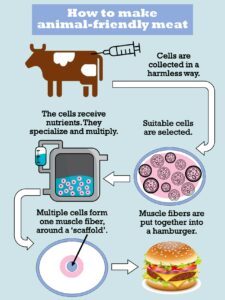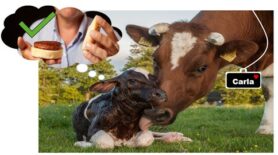Cultured Meat
There’s a new chicken in town
About the developments and the future of cultured meat.
An animal-friendly piece of meat might sound futuristic, but nothing could be further from the truth. It is expected that within five years, different types of meat will be available in the supermarket for which no animal has suffered. In 2013, the world’s first cultured meat burger was already produced in the Netherlands. Which obstacles has culturing meat already overcome since then, and what still needs to be done before you will have a cultured burger on your plate?
Auteur: Malika Weima | 22 oktober 2020
The scoop tasters of the first cultured burger did find it a bit bland in taste. In addition, the cultivation of the first cultured burger took a lot of time and money. This historic piece of meat cost around €250,000! Apart from these points for improvement concerning taste, time and money, the tasters clearly experienced the unique piece of meat as real meat. And that is exactly what it is.

The very first cultured burger, presented by Mark Post in 2013.
(© Mosa Meat, photo credit: David Parry)
Cultured meat ‘simply’ consists of animal cells. The process of culturing meat smartly copies the natural processes that normally take place in the body of an animal. The big difference: the cells do not grow inside an animal’s body. In this way, no animal has to die for a piece of cultured meat. Additionally, the production process is a lot less environmentally polluting than the current meat industry. The process of culturing meat therefore bodes well for people, animals and the environment. Yet, how does it work?
The process of growing meat starts with taking a small amount of cells from an animal (in an animal-friendly way of course!). As with the selection of a soccer team, suitable cells are selected to start the process. For the selected cells, a mixture of nutrients is on the menu – comparable to drinking an AA before the game. These nutrients cause the cells to multiply and specialize into muscle cells. As a final step, the muscle cells are placed around a ‘scaffold’. The muscle cells huddle around this scaffold: they pull towards each other and together form one muscle fibre. A lot of muscle fibres are eventually combined into, for example, a burger. Check out the process in the image ↓

(Image is based on 240318 © de Volkskrant – rb.;
the source of this photo CC BY-NC)
Overcome obstacles
In order to eventually get cultured meat in supermarkets, first a not-so-animal-friendly obstacle had to be removed from the process: the use of calf serum from unborn calves. In the first techniques, calf serum was still part of nutrients added to the cells. However, the goal of cultured meat is to be animal-friendly. That is why some cultured meat companies never used calf serum, but started looking for alternatives. Among these is the Dutch cultured meat company Meatable, explained by product-developer Maria Fernandes: “The nutrients are a combination of sugars, amino acids, salts and vitamins which all occur naturally. These substances can be sourced from several things, also from plants or algae.” In this way, meat can be cultured without the use of calf serum!
To eventually be able to compete with the current meat industry, the speed of culturing meat had to increase. Meanwhile, the company Meatable indicates that they can produce a same amount of meat that takes three years of a cows life, in just three weeks! In addition, way less animals are needed to be able to produce the same amount of meat. Nowadays, the technology has developed so far that a single cell donation from Carla the cow can be used to make several burgers in a short period of time. And we don’t have to bother her calf.

(source of this photo, © CC BY-SA)
Latest developments
Since the revealing of the first cultured meat burger in the Netherlands, the cultured meat industry has spread all over the world. Companies develop their own techniques and specialize in making all kinds of cultured meat. In addition to growing the ‘standard’ types of meat from cows and chickens, other companies specialize in fish farming. Even rare types of meat such as duck liver can already be cultured today.
Research into the cultivation of meat is now so far that different types of cells from an animal can be used as starting cells. One technique uses a cell donation from a cow’s muscle, the other technique takes cells from a chicken feather. Meatable uses cells that are extracted from an umbilical cord. “When a calf is born, we remove the cells from the umbilical cord. In this way we do not have to harm the calf, nor the mother” says Maria. In this way, each company works on its own method to get an animal- and environmental friendly piece of meat onto your plate.
“I would prefer to feed a cheap sugar beet to the cells”
When will cultured meat be on the menu?
The developments of recent years are very promising for the future of the cultured meat industry. However, there are still some hurdles to overcome before everyone has tasty and affordable cultured meat on their plate. According to Mark Post, the man behind the first cultured burger, the production process still has room for improvement. “The nutrients that go into the product are all quite expensive at the moment.” He adds: “I would prefer to feed a cheap sugar beet to the cells, but that is not going to work.” That is why cultured meat companies are still looking for solutions to obtain the nutrients in an easy and inexpensive way.
 Besides the fact that the nutrients are still pricey, there is one last obstacle before we can enjoy a piece of cultured meat in Europe: a new food safety law since January 2018. This law makes it a lot more difficult to bring new food products to the market. According to Mark Post, it can take a year and a half before the application for a new food product is approved.
Besides the fact that the nutrients are still pricey, there is one last obstacle before we can enjoy a piece of cultured meat in Europe: a new food safety law since January 2018. This law makes it a lot more difficult to bring new food products to the market. According to Mark Post, it can take a year and a half before the application for a new food product is approved.
Although this law slightly postpones the release date of cultured meat, we can expect these new “most versatile pieces of meat” on our plates around 2023!
Continue reading..?
Do you want to know more about the problems that cultured meat can (not) solve? Read this article.
Are you wondering what people think about eating cultured meat? Read this article.
Or check our knowledge clip!
Translated from Dutch/ Vertaald uit het Nederlands.
Important sources
Interview with Maria Fernandes, 8 October 2020.
Interview with Mark Post, 28 September 2020.
‘Kweekvlees wordt goedkoper dan gewoon vlees’ – Sprout.
(https://www.sprout.nl/artikel/startups/kweekvlees-wordt-goedkoper-dan-gewoon-vlees)
Kweekvlees is hard op weg naar uw bord – de Volkskrant. (https://www.volkskrant.nl/kijkverder/2018/voedselzaak/artikelen/kweekvlees-is-hard-op-weg-naar-uw-bord/?referrer=https%3A%2F%2Frobindefilm.nl%2F)
Bringing cultured meat to market: Technical, socio-political, and regulatory challenges in cellular agriculture. Geschreven door: Stephens, Di Silvio, Dunsford, Ellis, Glencross, & Sexton (2018). Gepubliceerd in: Trends in Food Science & Technology, 78, 155-166.

